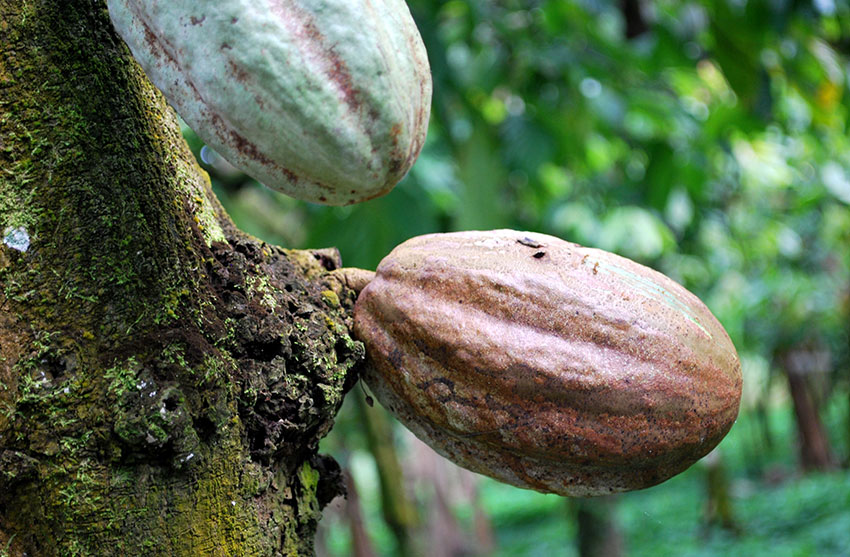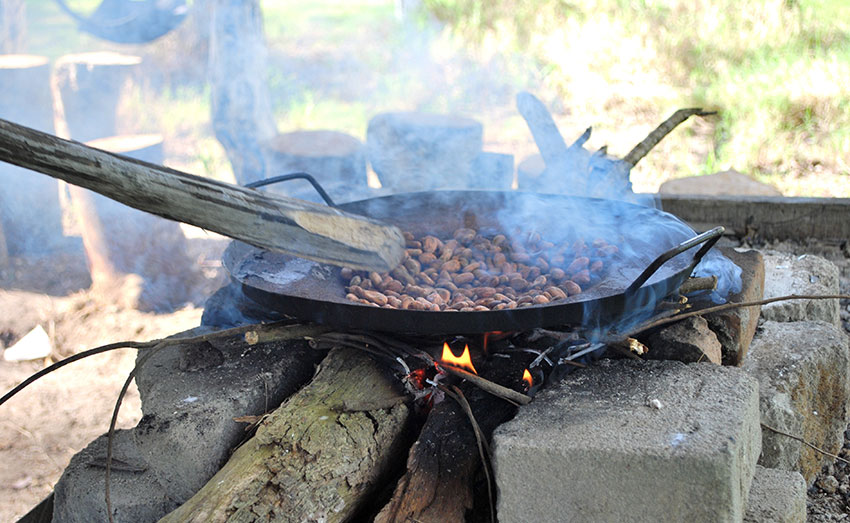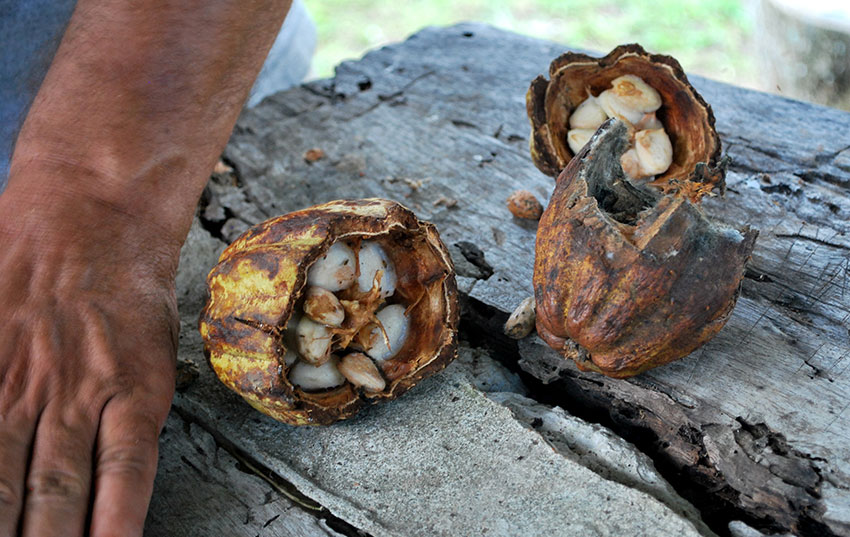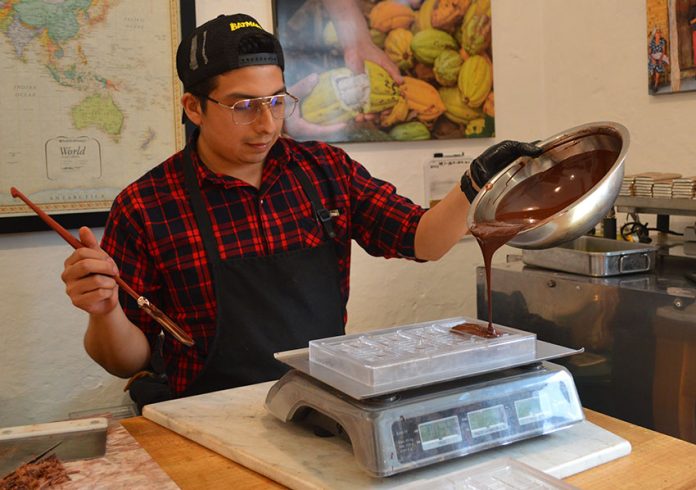As if avocados, tequila, and tomatoes weren’t enough, Mexico is also the land that gave the world chocolate.
But not as a candy. That’s a European invention.
The cacao tree, which the Aztecs believed was stolen from paradise by the deity Quetzalcóatl to give to man, has been grown for at least 4,000 years in much of what was the tropical territory of the Mayan empire and which today is most of southern Mexico.
Use of the beans spread into other parts of Mesoamerica through trade. For the Aztecs, the cacao beverage was reserved only for the emperor and certain persons of high social rank. They drank it bitter, even adding chile pepper, but depending on time and place the cacao could be mixed with honey, allspice, achiote, Mexican pepperleaf or pinole (a type of ground corn), but never sugar or milk. After the Conquest, the Spanish began drinking it, but they added the sugar.
Then and now, the most traditional way to prepare cacao is to toast the beans on a comal (griddle), then grind them by hand. The rough paste is mixed with sugar and sometimes other flavorings, then pressed into hard tablets or bars. This chocolate de mesa can be eaten but does not have the taste and texture of a candy bar. A portion of the chocolate is broken off and added to simmering water or milk until is it dissolved. The last step is to make a froth by stirring rapidly, spinning a tool called a molino for this purpose, or pouring it into a cup from a height.

Chocolate as the world knows it is the result of European tinkering. In 1528, Spanish conqueror Hernán Cortés took cacao to Spain. Its consumption spread and different European chocolatiers innovated both forms and processes to make the highly refined hot cocoa, chocolate bars and other treats preferred today.
Mexico never lost its taste for cacao-based drinks, especially in the center and south of the country. The three states that drink the most are also the main producers: Tabasco, Chiapas, and Oaxaca. The Oaxacan version is best known because of that state’s tourism industry and tends to contain higher percentages of sugar. This is especially true for major brands such as Mayordomo and La Soledad.
In Tabasco and Chiapas, chocolate is generally sold with the percentage of cacao indicated. It is possible to get 100% cacao beverage, with no sugar at all. Chocolate is popular in the center of the country, but without local production and the infamous Chocolate Abuelita by Nestlé is nearly ubiquitous. (This and other inexpensive “chocolates de mesa” can have as little as 3% cacao, along with soy lecithin and artificial flavors.)
Cacao is also used to prepare cold drinks, which go by various names, including pozol, tascalate, tejate and popo, depending on the region. The cacao is mixed with fermented corn and other flavorings and the drinks are a lot more refreshing than they sound.
Cacao that is prepared traditionally is a real food, maintaining its nutritional benefits such as antioxidants, protein, fiber, vitamins A, B2 and others, phosphorus, iron and potassium, according to biologist Julio Salazar of Alkymia Ethical Food in San Cristóbal de las Casas, Chiapas. Cacao is very similar to wine, loaded with flavor compounds. Processes, locations, and years affect the flavor. To preserve these qualities, beans need to be fermented, roasted, ground, and even poured into molds with great care.
The concerns about cacao go beyond just taste. Two-thirds of the world’s production is in east Africa, often using child labor. Mass production with questionable ethics means highly abundant, cheap, low-quality chocolate for the world’s sweet tooth, unfortunately, including Mexico’s.

According to a national association of chocolate and candy manufacturers, Mexico grows 27,000 tonnes of cacao each year, representing only 0.5% of the world’s production. There are about 37,000 producers, but growers are almost always indigenous families producing small quantities. Although they earn the least from the chocolate market, their cacao still costs three to four times the international price. To make things worse, cacao production in Mexico fell about 50% over the past decade or so because of disease and non-profitability.
Mexico produces three types of cacao: criollo, forastero and trinitario. Criollo produces the finest chocolate, but accounts for only 10% because it is susceptible to disease and infestations. Forastero is the most common (70%) because it is hardy. Trinitario is a hybrid of the first two.
Tabasco grows 66% of Mexico’s cacao, followed by Chiapas at 33% and smaller quantities are grown in other states in areas that border these two. Tabasco may be the best place to visit and see how cacao is grown and processed. It has a well-marked Chocolate Route (Ruta de Chocolate) connecting traditional haciendas that open their doors to visitors.
One of these is Wolter Chocolates, founded at Hacienda La Luz in 1958. The operation has cacao fields and processes harvests into both drinking and eating chocolates, welcoming over 14,000 tourists each year. For the past 10 years or so, a fine chocolate culture has been growing in San Cristóbal, started in part with the opening of Otoch Chukwá by a Tabasco chocolate family.
There is no internationally known Mexican chocolatier, not even for drinking chocolate. One reason is that the Europeans have taught the world to expect a highly refined product, much the way it expects white sugar and flour. Mexican chocolate has a courser texture because of its fiber content.
Almost all of Mexico’s production is for domestic consumption, and what little is exported is for niche markets. Salazar says this represents an opportunity with the right kind of consumer education. In just three years San Cristóbal’s Alkymia has built a small but international and very loyal client base.

Mexico has some relatively large chocolate makers including Chocolatera Moctezuma and Chocolate Rey Amargo, whose products can be found in supermarkets and specialty stores in Mexico. But better quality is generally had with small, local producers.
Both large and small chocolatiers can be found on the internet, often simply by googling “chocolate” and the name of the company or state you are interested in getting cacao from.
Leigh Thelmadatter arrived in Mexico 17 years ago and fell in love with the land and the culture. She publishes a blog called Creative Hands of Mexico and her first book, Mexican Cartonería: Paper, Paste and Fiesta, was published last year. Her culture blog appears weekly on Mexico News Daily.
